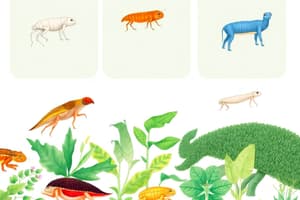Podcast
Questions and Answers
Які три домени життя існують?
Які три домени життя існують?
- Прокаріоти, Еукаріоти, Гриби
- Рослини, Тварини, Протисти
- Бактерії, Гриби, Тварини
- Бактерії, Археї, Еукаріоти (correct)
Хто вперше ввів формальну систему біологічної класифікації?
Хто вперше ввів формальну систему біологічної класифікації?
- Грегор Мендель
- Карл Лінней (correct)
- Джеймс Уотсон
- Чарльз Дарвін
Яка з груп належить до домена Еукаріоти?
Яка з груп належить до домена Еукаріоти?
- Археї
- Протисти
- Гриби (correct)
- Бактерії
Яку групу класифікації належить гуска nēnē?
Яку групу класифікації належить гуска nēnē?
Що таке прокаріоти?
Що таке прокаріоти?
Скільки королеств життя існує в домені Еукаріоти?
Скільки королеств життя існує в домені Еукаріоти?
Які основні типи життєвих циклів існують у організмів залежно від стадій диплоїдності та гаплоїдності?
Які основні типи життєвих циклів існують у організмів залежно від стадій диплоїдності та гаплоїдності?
У яких організмів спостерігається гаплонтний життєвий цикл?
У яких організмів спостерігається гаплонтний життєвий цикл?
Які організми починають своє життя у диплоїдному стані?
Які організми починають своє життя у диплоїдному стані?
Чим відрізняється диплогаплонтний життєвий цикл від інших типів життєвих циклів?
Чим відрізняється диплогаплонтний життєвий цикл від інших типів життєвих циклів?
Що виробляє гаметоптичне покоління в рослин?
Що виробляє гаметоптичне покоління в рослин?
Що спричиняє початок нового гаметоптичного покоління у рослин?
Що спричиняє початок нового гаметоптичного покоління у рослин?
Study Notes
Living Organisms: Classification and Life Cycles
Introduction
Living organisms encompass a diverse range of species that inhabit the Earth, each with unique characteristics and life cycles. The classification of living beings helps scientists understand their evolutionary relationships and how they fit into the larger ecosystem. This article focuses on two key aspects: classification and life cycles of various types of organisms.
Classification
Classifying living organisms is crucial for understanding their roles within ecosystems and their place in the history of life on Earth. Carl Linnaeus, a Swedish botanist, introduced the first formal system of biological classification in 1753, known as the Linnean system. This hierarchical system groups organisms based on shared traits and characteristics, from the broadest level (domain) down to specific traits (species).
There are three domains of life: Bacteria, Archaea, and Eukarya. Bacteria and Archaea are single-celled microorganisms that do not have DNA contained within a nucleus (prokaryotes), while Eukarya includes all organisms with DNA in a nucleus (eukaryotes).
Within the domain of Eukarya, there are four kingdoms: Protista, Fungi, Plantae, and Animalia. Organisms with similar characteristics are grouped within these broad categories. For example, a Hawaiian goose or nēnē (Branta sandvicensis) is classified as a bird (Aves) in the class Aves, order Anseriformes, family Anatidae.
Life Cycles
Organisms' life cycles can be categorized into three main types based on their stage of diploidy (two sets of chromosomes) and haploid (one set of chromosomes): haplontic, diplontic, and diplohaplontic. Haplontic species, such as bacteria and certain algae, have a one-generation life cycle where individuals alternate between haploid (during growth and reproduction) and diploid (as spores) stages. Diplontic species, like animals, begin their lives in a diploid state and become haploid only during reproduction. Finally, diplohaplontic species, including plants, have both diploid and haploid generations in their lifecycle.
Plants specifically undergo an alternation of generations, where they produce two different multicellular forms. The gametophytic generation produces sex cells, which then develop into sporophytic plants through fertilization. Sporophytic plants grow into mature plants that eventually produce spores and initiate a new gametophytic generation. This process is known as "alternation of generations" and allows for a continuous cycle of reproduction and development.
In summary, classification and life cycles play essential roles in understanding living organisms' relationships and behaviors. The Linnean system helps scientists organize and categorize organisms based on shared traits, while life cycles provide insights into the stages of an organism's existence and reproductive patterns.
Studying That Suits You
Use AI to generate personalized quizzes and flashcards to suit your learning preferences.
Description
Explore the classification of living organisms and their diverse life cycles, shedding light on evolutionary relationships and ecosystem roles. Learn about the Linnean system of classification and the different types of life cycles, from haplontic to diplohaplontic, including the alternation of generations in plants.




